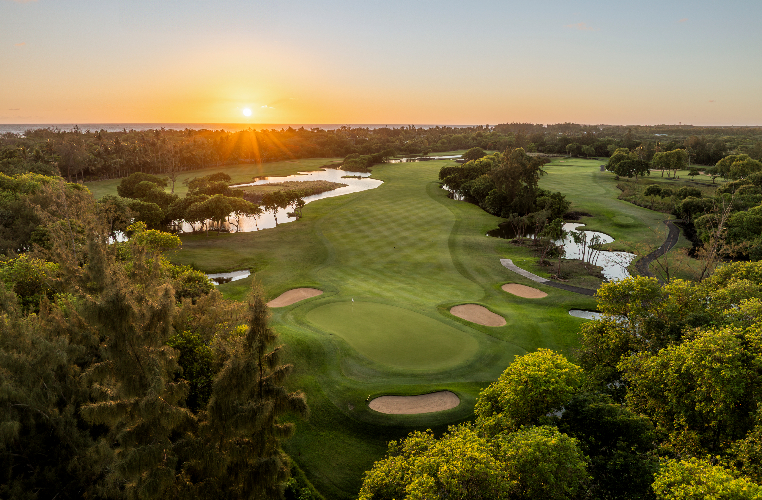 |
| The 18th green after the renovations |
The final major championship of the season takes place this week at the Evian Resort Golf Club in Evian-les-Bains, France.
This is the same location as the Evian Masters Golf Course, home to the Evian Masters for the last 19 years since 1994.
However, several major changes have been made this year, particularly to the fifth, 15th, 16th, 17th and 18th holes.
The greens and tee boxes have all been enlarged and the final four stretch of holes – 15 to 18 – is to be known as the ‘Evian Puzzle’.
Spectators will be able to see all the action across five greens from natural seating areas on the grassy banks, particularly near the 17th tee and 18th green.
The course opened on 1st July 2013 after nine months of titanic work. Construction began on 18 September and was completed on 29 June after a heavy winter, during which time the course was under snow.
The challenging course is now a par 71 (35-36) and, at 6428 yards for the championship, is playing longer, with scores expected to be higher than in previous years.
Although the majority of the previous routing remains in place, hole five is now a picturesque par-3 played over water, as opposed to a par 4.
The 13th tee has been moved back and is a par 5. The 15th is a par-5, with a remodelled green protected by bunkers.
In the position of the old 15th green, the new par-3 16th plays over an attractive cascading water feature.
The 17th is now a par-4, played in a similar position to the old 16th hole, but with a remodelled and repositioned green.
The 18th is now a long and challenging par-4, with a much larger lake protecting the right side of the green, which has been remodelled and positioned at a different angle.
In general, the course is more open with an increased number of panoramic views across Lac Leman and the greens are much more undulated.
 |
The Evian Resort Golf Club in Numbers:
(Kindly supplied by European Golf Design)
77 – The number of new bunkers on the course. The previous large flat bunkers have been replaced by a smaller, deeper and more challenging bunker style.
80,000 – The cubic metric amount of earth moved in redeveloping the course.
20 – The number of greens which have been redesigned and rebuilt. On average, the greens have increased in size by up to 40%, allowing for more flexibility in pin position opportunities and more undulation within the putting surfaces.
71 – The new par of the Evian golf course. The most significant changes to the course have been in the redesign of the 5th hole from a par 4 to a par 3; the 13th has been extended to a reachable par 5; the 16th is now the short par 3 and the 17th a par 4; while the 18th has been changed from a short par 5 into the longest and most demanding par 4 on the course.
6428 – The total number of yards from the championship tees.
3 – The number of cascading ponds which defend the front of the new short downhill par 3 16th hole.
176 – The number of new trees planted around the course.
 |
| Helen Alfredsson tees off on the remodelled par-3 5th hole |
Evian Resort Golf Club
 |
| View of the fifth hole from behind the green |
Hole #1 – Par 4 395 yards
A straightaway par 4, the opening hole will undoubtedly set the tone for the round. While the fairway is ample in width, players will need to avoid fairway bunkers on both the left and the right and the approach into the green will require a mid-iron or hybrid shot. With two tiers and some significant slope, the first green will test the players’ touch right out of the gate.
Hole #2 – Par 3 165 yards
Club selection is critical to this severely downhill par 3 measuring 165 yards. The green, which now can be seen in total from the teeing ground, is divided into two sections by a large knoll. While a front hole location gives players a solid look at birdie, a back hole location could prove treacherous for players who misjudge the distance. A shot landing on backside of the knoll will likely come to rest in the back fringe or perhaps suffer a more severe fate– roll into the deep back bunkers.
Hole #3 – Par 4 343 yards
The second shortest par 4 on the course, the third hole presents players with a birdie opportunity if the tee shot is well-placed. In order to avoid the right-hand fairway bunkers, longer hitters may elect a fairway metal off the tee. Most players will be left with a short-iron or wedge into a fairly tricky green.
Hole #4 – Par 4 414 yards
Measuring 414 yards, the par-4 fourth hole is the first of four par 4s on the course measuring more than 400 yards. Players must hit the fairway in order to successfully navigate the long, uphill second shot. While most players will be required to hit a fairway metal or long iron for an approach, the green is one of the largest on the golf course.
Hole #5 – Par 3 179 yards
The completely redesigned 5th hole is one of the most picturesque on the golf course. However, players must not be fooled by its beauty. The green is guarded in the front by a new water feature which cuts closer to the green than can be seen from the teeing ground. Greenside bunkers flank both the left and the right sides of the green. While the putting surface is large, it is full of delicate slopes. Depending on the hole location, this hole may prove to be the toughest par 3 on the golf course.
Hole #6 – Par 4 377 yards
The left-hand fairway bunker provides the focal point for the tee shot on this manageable par 4. While players have ample room to drive the ball, the green is well-protected on the right and front-left by deep, challenging bunkers. The bunkers, coupled with the slopes on the putting surface, will make this seemingly benign par 4 more difficult.
Hole #7 – Par 5 529 yards
Expect the par-5 7th to play a bit longer and tougher than in the past. Trees line both sides of the teeing ground creating arguably the most impressive driving hole on the course. A well-negotiated drive will put the player in a good position to pursue a rare front-nine birdie opportunity. While the yardage suggests a three-shot hole for the field, watch for the tees to be moved forward to invite players to go for the green in two.
Hole #8 – Par 3 189 yards
Coming off the par-5 7th, players will be faced with a long, straightaway par 3. While the longer hitter will likely select a mid-iron, most players will be required to play a hybrid or fairway metal into this large green. A tee shot finding the green will present the player with a birdie/par opportunity. Miss the green into one of the deep bunkers and saving par will be a challenge.
Hole #9 – Par 5 475 yards
Players can breathe a bit on the closing hole of the opening nine. The par 5 9th is the shortest par 5 on the golf course and it should yield many birdies, as well as give players a realistic chance at eagle. At only 475 yards, most players finding the fairway off the tee will likely be going for the green in two.
Hole #10 – Par 4 406 yards
With a down-hill tee shot, this dogleg right par-4 plays shorter than the yardage on the scorecard. To have a clear shot at the green, players must avoid the trees on both the left and right-hand sides of the fairway. While the 10th green is the only green on the golf course void of greenside bunkers, it is also the narrowest green on the golf course. With two tiers (left-to-right), players will approach this green as two greens in one. Hit the wrong tier and a two-putt will be a challenge.
Hole #11 – Par 4 353 yards
Players head back up the hill on this dogleg left par-4. Fairway bunkers on the right-hand side lead the players’ eye up the fairway. Hit it left off the tee and a pitch out will be required. The second shot plays sharply uphill and the green is well protected on the left with greenside bunkers. Club selection into the green will be the key to a birdie opportunity.
Hole #12 – Par 4 428 yards
Players will face a tough test at the demanding par-4 12th. Not only is the hole the second longest par-4 on the course, but the fairway is also one of the toughest to hit. The fairway, which slopes hard right to left, is protected by rough on the right and fairway bunkers on the left, making hitting this fairway a daunting task. Hit the fairway and players still face a long approach shot off of a hanging lie. To make the hole even more difficult, the green complex is one of the most severe on the course.
Hole #13 – Par 5 499 yards
After the demanding 12th hole, players will be able to catch their breath on the medium-lengthened par-5 13th. Formerly a par 4, the 13th hole swings gently from right to left. Players finding the fairway off the tee will have a realistic chance to reach the green in two shots. The approach plays slightly downhill, and the open front of the green further entices the player to chase a second shot close to the putting surface.
Hole #14 – Par 3 221/199 yards
Listed as the longest par 3 on the golf course, the par-3 14th plays dramatically downhill. The green is large and undulating and it is well protected on the right and right-front by deep and rather treacherous bunkers. Watch for players to work the ball off of the left side of the green to make use of the gentle slope designed to help feed the ball onto the green. Two different teeing grounds from two different angles will be used to further test the players.
 |
| The 15th green |
Hole #15 – Par 5 527 yards
Once players complete the par-3 14th, they turn their sights to the exciting par-5 15th which heads back towards the Evian Resort Clubhouse. At 527 yards, players will likely need three shots to reach the green in regulation. Off the tee, players must avoid the strategically positioned fairway bunkers on the left side. For the second shot, players will be faced with the decision to either lay up short of the tricky cross bunker or to work over or around it. While players will likely have a wedge or short iron shot for their third shot, they must be cognizant of where they place their ball on this subtlety sloped green. A shot coming to rest beyond certain pin placements will leave the player with a treacherous putt. While the par-5 15th measures 527 yards on the scorecard, look for the tees to be moved forward on the weekend to entice players to go for the green in two.
 |
| The new 16th green |
Hole #16 – Par 3 155 yards
The brand new 16th is a striking par 3 protected by water and tricky greenside bunkers. Club selection will be the key to negotiating this very difficult hole. The green, which sits on a bit of a slant, creates an illusion from the tee that the green is narrower than it actually is. Front right and left pin placements look intimidating and they will force players to challenge the water feature. Hitting a shot tight to the hole will require supreme distance control and inner fortitude.
Hole #17 – Par 4 331 yards
Don’t be deceived by the short yardage on this dogleg right par-4. While a well-placed drive will give the player a good look at birdie, a wayward drive will leave the player scrambling to make par. The tee shot, framed by the fairway bunkers on the left and the trees on the right, will likely lead many players to elect a fairway metal off the tee. On the approach, the hole flows sharply uphill to a two-tiered green which is well-protected by deep and menacing greenside bunkers. While the putting surface is quite large, players must be cognizant of the tiers and gentle slopes when positioning their approach shots.
 |
| The 18th green |
Hole #18 – Par 4 442
Measuring a massive 442 yards, the par-4 18th is the longest and most demanding par 4 on the golf course. Length, accuracy and courage will all be required to conquer this dramatic finishing hole. Finding the fairway off the tee is an absolute must for players to successfully navigate the water hazard fronting the green. Miss the fairway and players will likely need to lay up short of the hazard. Large, deep bunkers line the right-side of the green. For players stretching to reach the green in regulation, a suitable bail out area has been designed short and left of the green. Come Championship Sunday, the 18th hole will test the mettle of even the strongest hearts.



















